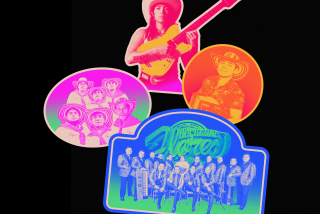A Family Affair : Oxnard clan keeps the folk music of southern Mexico’s Vera Cruz region alive.
The musically inclined Herrera family of Oxnard gives a new twist to the adage, “The family that plays together, stays together.”
For 16 years, family members have been researching and performing musica jarocha , a style of folk music from southern Mexico’s region of Vera Cruz.
According to Fermin Herrera, the group’s founder and director, there are 17 members within two generations of the family who can play the music. Many of them were taught by him.
But when it is time to perform, it is the core group, composed of Fermin, sister Maria-Isabel Herrera de Miranda, brothers Jorge, Andres, Tomas, and son, Xocoyotzin--who usually take the stage.
Their six-member group, El Conjunto Hueyapan, which means the group from the coast, has been spreading the Vera Cruz sound to festivals and other venues across the country. Along the way, they have played at the nation’s Bicentennial celebration in Washington, Dorothy Chandler Pavilion, Hollywood Bowl, Greek Theatre and Disneyland.
Their music is included on “Folk Music of Ventura County,” an album made by the Thousand Oaks Library, and on recordings for the Smithsonian Institution.
This Saturday evening, Ventura County residents will have a rare opportunity to see them perform locally in traditional costume as part of the Ventura Department of Parks and Recreation’s “Summer Performance Series” at the Olivas Adobe Historical Park.
The term musica jarocha may not ring a bell with most people. But anyone who has seen the film “La Bamba” will remember the bar scene in which harpist Fermin and the popular East Los Angeles group Los Lobos perform a traditional jarocho version of the title song.
“ Son Jarocho, or the sound from Vera Cruz, is part of a very broad tradition of Mexican music, with the most popular sound being mariachi music,” said Fermin, a professor of Chicano studies at Cal State Northridge and a visiting professor of ethnomusicology at UCLA. The instruments used in jarocha music, he said, are indigenous instruments that evolved from prototypes brought to Mexico by Spaniards in the 1500s.
The basic instrument is the eight-stringed guitar-type jarana , which, unlike the guitar, is carved out of a solid block of wood, with only the sound board being added. Another guitar-type instrument, the four-stringed requinto , provides melody, while the 36-string Vera Cruz folk harp, the mecahuehuetl , is played by plucking or by percussive movements with the palms of the hands.
Structurally, jarocha music is very simple. With no score sheets for instruments, improvisation and individual style are important parts of each performance.
“Most songs consist of two or three verses and a chorus,” Fermin said. “And a lot of the lyrics of Vera Cruz music are nonsense-rhythmic fillers.”
One particular type of song, la mentira or humorous lie, has the singer creating an exaggerated falsehood. For instance, Xocoyotzin, 19, sings, “When my mother gave birth to me, my father wasn’t born yet.”
The Herreras say their musical appreciation was learned from their parents, who came to Oxnard as farm workers in the late ‘30s or early ‘40s. Andres said their father played clarinet in spirited local bandas . And Isabel, as she is known, an associate professor of Chicano studies at Cal State Northridge who plays the jarana , remembers that in the early ‘50s, her father used to take the children to the Boulevard Theater in Oxnard “to hear the Mexican harpist Andeas Huesca.”
During the 1960s, Fermin became a big fan of Mexican folk music. He shared his record collection with his siblings, who also developed an interest in preserving the Vera Cruz sound.
When KMEX television Channel 34 broadcast “Un Canto de Mexico,” a program featuring jarocho groups and other types of Mexican music, Isabel said she was hooked.
“Then I could see as well as hear the master musicians.” About that time, the siblings decided to share their rediscovered musical heritage.
In the early 1970s Fermin obtained a grant and opened “Colegio Qtzalcoatl,” a community school in Oxnard’s Colonia area that provided instructors to the community and established a performance group in dance and in music. The school, said Andres, lasted about two years, until the grant money ran out.
“The people who took instruction are now teaching or performing with groups themselves,” Andres said.
“We hired musicians from L.A. to teach harp and the other instruments,” Fermin said. “That’s how I got started. Then I went on my own to study in Vera Cruz.” Later, he returned to southern Mexico with his siblings to learn from master musicians.
Today, the five Herrera siblings continue to act as mentors in their community. “We felt that this was an important art form. And our children have learned from us, as have their friends, that there is something of great value in our family and culture,” said Andres.
Something that they all agreed should be nurtured and maintained for future generations.
“Some people have referred to folk music as a relic or museum piece,” said Fermin. “That’s not the case with our music. Each performance is an act of creation.”
* WHERE AND WHEN
El Conjunto Hueyapan, will perform Saturday, 7-9 p.m. as part of the Olivas Adobe Summer Performance Series in the Olivas Adobe courtyard, 4200 Olivas Park Drive, near the Ventura Marina.Adults, $5; children age 12 and younger, $2. Children age 6 and younger are admitted free. Guests are welcome to bring a blanket and picnic meal. Refreshments will be sold at the adobe.
More to Read
Sign up for Essential California
The most important California stories and recommendations in your inbox every morning.
You may occasionally receive promotional content from the Los Angeles Times.










